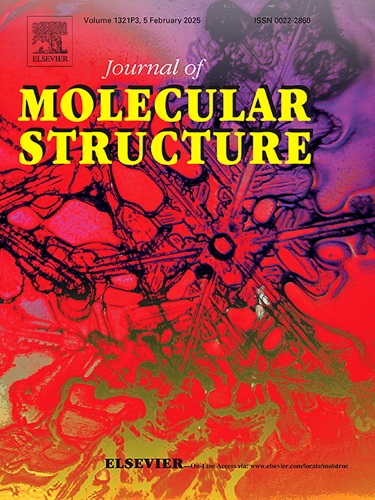Zwitterionic manganese(II) MOF based on bisimidazole tetracarboxylic acid ligand exhibiting reversible photochromism, erasable inkless printing and amine-selective sensing
IF 4
2区 化学
Q2 CHEMISTRY, PHYSICAL
引用次数: 0
Abstract
As chromic materials, viologen-based metal-organic frameworks (MOFs) with the electron-deficient bipyridinium have received enormous attentions. The imidazole nitrogen atoms possess the high basicity, which tends to be protonated, leading to the electron-deficient imidazolium that also may induce color changes. Along this line, by using the bisimidazole tetracarboxylic acid, a three-dimensional (3D) zwitterionic Mn-MOF was synthesized under solvothermal conditions, namely [Mn(H4L)(H2O)2]·2H2O (Mn-MOF-1) (H6L = 4,4′,4″,4‴- (1,4-phenylenebis (1H-imidazole-2,4,5-triyl))tetrabenzoic acid). Mn-MOF-1 shows reversible color changes with high contrast color from light yellow to green under visible light irradiation, which can be attributed to the generations of radicals through photoinduced intermolecular electron transfer (ET) between carboxylate and imidazolium, which can be confirmed by the electron paramagnetic resonance (EPR) and the density function theory (DFT) calculations. To advance the practical application, we have fabricated [Mn-MOF-1]-filter paper and [Mn-MOF-1]-PMMA films, which can be used for inkless and erasable printing. Besides, Mn-MOF-1 can also show color changes for the small primary amines such as ethylamine (EA), n-propylamine (PA) and n-butylamine (BA). This size-selective chromic behaviors can be interpreted with host-guest electron transfer generating radicals in the specific confined space. This work provides a promising strategy to promote the development of stimulus-responsive multifunctional MOF-based materials.

求助全文
约1分钟内获得全文
求助全文
来源期刊

Journal of Molecular Structure
化学-物理化学
CiteScore
7.10
自引率
15.80%
发文量
2384
审稿时长
45 days
期刊介绍:
The Journal of Molecular Structure is dedicated to the publication of full-length articles and review papers, providing important new structural information on all types of chemical species including:
• Stable and unstable molecules in all types of environments (vapour, molecular beam, liquid, solution, liquid crystal, solid state, matrix-isolated, surface-absorbed etc.)
• Chemical intermediates
• Molecules in excited states
• Biological molecules
• Polymers.
The methods used may include any combination of spectroscopic and non-spectroscopic techniques, for example:
• Infrared spectroscopy (mid, far, near)
• Raman spectroscopy and non-linear Raman methods (CARS, etc.)
• Electronic absorption spectroscopy
• Optical rotatory dispersion and circular dichroism
• Fluorescence and phosphorescence techniques
• Electron spectroscopies (PES, XPS), EXAFS, etc.
• Microwave spectroscopy
• Electron diffraction
• NMR and ESR spectroscopies
• Mössbauer spectroscopy
• X-ray crystallography
• Charge Density Analyses
• Computational Studies (supplementing experimental methods)
We encourage publications combining theoretical and experimental approaches. The structural insights gained by the studies should be correlated with the properties, activity and/ or reactivity of the molecule under investigation and the relevance of this molecule and its implications should be discussed.
 求助内容:
求助内容: 应助结果提醒方式:
应助结果提醒方式:


